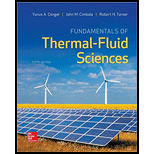
a)
The exit temperature of air and the entropy generated during the process.
a)
Explanation of Solution
Given:
The volume flow rate of the air
The initial pressure of the air
The initial temperature of the refrigerant-134a
The initial pressure of the refrigerant-134a
The quality of the refrigerant-134a is0.3
The mass flow rate of refrigerant-134a
The surrounding temperature
The rate of heat gain from the surrounding
Calculation:
Refer Table A-12, “Saturated refrigerant-134a-Pressure table”, Obtain the following properties at saturated pressure of 120 kPa
Saturated liquid enthalpy,
Evaporated enthalpy,
Saturated vapor enthalpy,
Saturated vapor entropy,
Saturated liquid entropy,
Evaporated entropy,
Refrigerant –134a enters and leaves at the same pressure. Hence,
Calculate the initial enthalpy of the refrigerant
Calculate the initial entropy of the refrigerant.
Refer Table A-1E, “the molar mass, gas constant and critical–point properties table”,
The gas constant of air at room temperature as
Calculate the mass flow rate of air
Write the expression for the mass balance of the system.
Here, mass flow rate into the control system is
Substitute
Refer the Table A-2, “Ideal-gas specific heats of various common gases”, select the value of the specific heat at constant pressure value of air as
Write the expression for the energy balance equation for closed system.
Here, rate of energy transfer into the control volume is
Substitute
Thus, the exit temperature of air is
Write the expression for the rate of entropy balance for the system.
Here, rate of entropy in the system is
For the steady flow system, change of entropy in the system is zero.
Substitute
Thus, the entropy generated during the process is
b)
The exit temperature of air and the entropy generated during the process.
b)
Explanation of Solution
Substitute
Thus, the exit temperature of air is
For the steady flow system, change of entropy in the system is zero.
Substitute
Thus, the entropy generated during the process is
Want to see more full solutions like this?
Chapter 8 Solutions
Fundamentals of Thermal-Fluid Sciences
 Elements Of ElectromagneticsMechanical EngineeringISBN:9780190698614Author:Sadiku, Matthew N. O.Publisher:Oxford University Press
Elements Of ElectromagneticsMechanical EngineeringISBN:9780190698614Author:Sadiku, Matthew N. O.Publisher:Oxford University Press Mechanics of Materials (10th Edition)Mechanical EngineeringISBN:9780134319650Author:Russell C. HibbelerPublisher:PEARSON
Mechanics of Materials (10th Edition)Mechanical EngineeringISBN:9780134319650Author:Russell C. HibbelerPublisher:PEARSON Thermodynamics: An Engineering ApproachMechanical EngineeringISBN:9781259822674Author:Yunus A. Cengel Dr., Michael A. BolesPublisher:McGraw-Hill Education
Thermodynamics: An Engineering ApproachMechanical EngineeringISBN:9781259822674Author:Yunus A. Cengel Dr., Michael A. BolesPublisher:McGraw-Hill Education Control Systems EngineeringMechanical EngineeringISBN:9781118170519Author:Norman S. NisePublisher:WILEY
Control Systems EngineeringMechanical EngineeringISBN:9781118170519Author:Norman S. NisePublisher:WILEY Mechanics of Materials (MindTap Course List)Mechanical EngineeringISBN:9781337093347Author:Barry J. Goodno, James M. GerePublisher:Cengage Learning
Mechanics of Materials (MindTap Course List)Mechanical EngineeringISBN:9781337093347Author:Barry J. Goodno, James M. GerePublisher:Cengage Learning Engineering Mechanics: StaticsMechanical EngineeringISBN:9781118807330Author:James L. Meriam, L. G. Kraige, J. N. BoltonPublisher:WILEY
Engineering Mechanics: StaticsMechanical EngineeringISBN:9781118807330Author:James L. Meriam, L. G. Kraige, J. N. BoltonPublisher:WILEY





